
By SERGEY KADINSKY
Forgotten New York correspondent
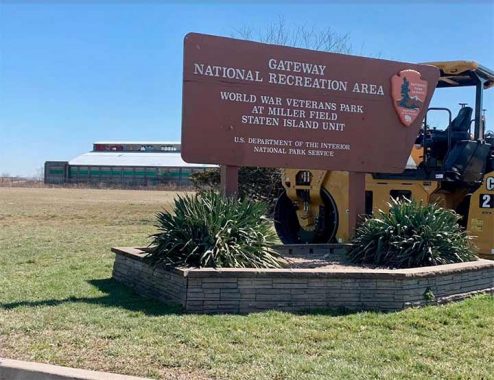
FROM the Verrazano Bridge area heading south, Father Capodanno Boulevard is a pedal-to-the-metal shorefront road that was intended to serve as a highway. Among Robert Moses’ projects, this was one of the unrealized proposals. At 2.6 miles in length, the road has an abrupt end at Midland Beach, where a traffic turnaround marks the entrance to Miller Field.
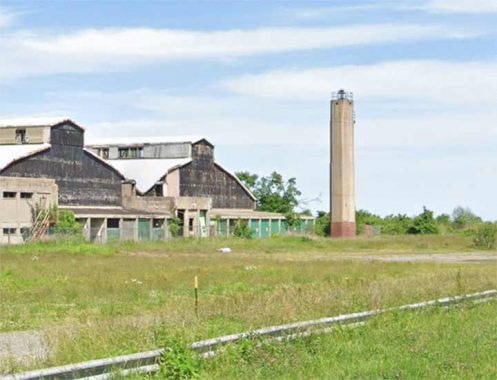
At the turn of the 20th century, Miller field was the Elm Tree farm of the Vanderbilt family, descendants of colonial Dutch settlers who made their wealth in railroads. Facing the ocean at the site of the hangars was a massive elm tree that appeared on old maps. It served as a navigational marker and later had lighthouses on this spot to assist ships. In 1939, the final version of Elm Tree Light was completed, a 65-foot concrete tower that aided airplanes and ships, with a beacon for each. Since the decommissioning of Miller field in 1969, the lighthouse no longer shines.
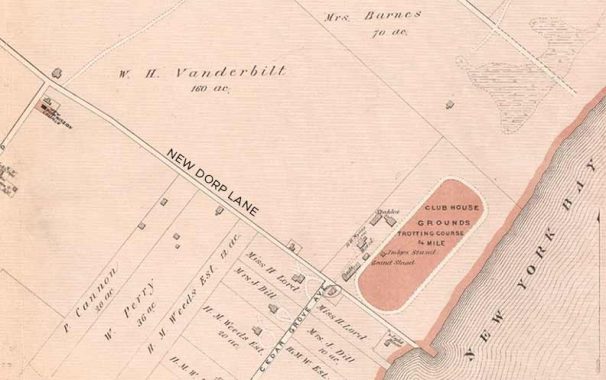
As the Vanderbilts amassed wealth from their railroad empire, the farm in New Dorp hosted a trotting course for horse enthusiasts, as seen on this map from 1873. William Henry Vanderbilt’s son George Washington Vanderbilt kept his father’s wooden country home and added his own mansion on site, which he humbly named the White House. It sounded presidential except that his namesake was also the only president who never lived in the actual White House. Billy, as he was known, later went on to build the largest residence in the country, Biltmore (appropriately named) in North Carolina.
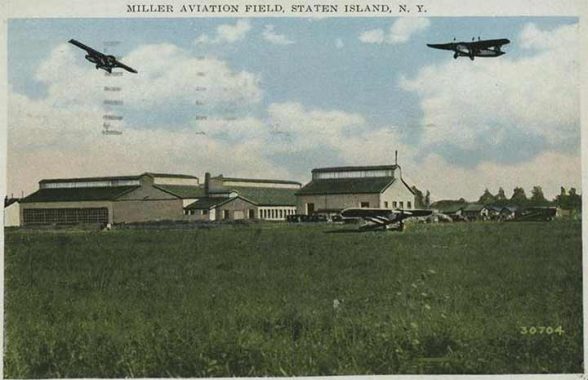
Shortly after World War One ended, the federal government purchased the farm, demolished its mansion, removed its trees and established an airfield. In 1920 it was named Miller Field for Captain James E. Miller, the first American aviator killed in action serving for the U.S. in that war. For its duration as a defensive airfield, it always had a grass runway, with a concrete ramp for seaplanes that launched from the beach.
It is likely the hangars will not become a recreation center as the sizable Ocean Breeze Track & Field Center is located a mile to the east of Miller Field. There are very few abandoned hangars to be seen in this city. Kevin documented those at Flushing Airport in 2001, but those have since been demolished. Deemed unstable by the National Parks Service, Miller Field’s Hangar 38 will also meet the same fate in the near future.
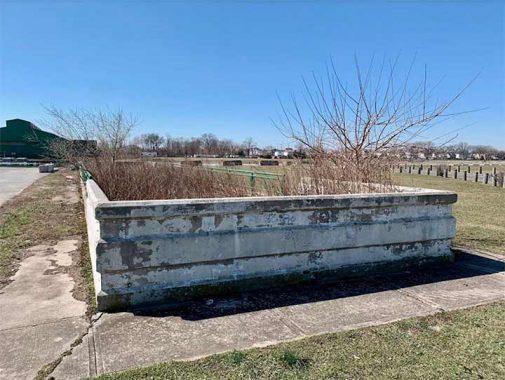
Staten Island has the largest Italian-American population among the five boroughs, and that’s why I was surprised to see an abandoned bocce court in this park. Within the city’s parks network, there are 34 public bocce courts. There used to be more but as demographics changed, many of these courts fell into disuse. Kissena Park, Flushing, is a notable exception, where Asian-American newcomers learned the game and kept that court in use, alongside older Italian players.

Facing the beach is an abandoned concrete observation tower built during World War Two to look out for Nazi submarines. At the time, Miller Field was designated as an extension of nearby Fort Wadsworth. Similar blockhouses can be seen near the tip of Breezy Point in Queens, Montauk Point, and Cape May.

In 1972, Miller Field was designated a National Parks site. Combined with Floyd Bennett Field, Plum Beach, Jamaica Bay, Fort Wadsworth, and Sandy Hook, these sites are within the Gateway National Recreation Area, an urban national park that preserves the coastal defense and natural beauty of the city’s harbor approaches. The commander’s office at Miller Field became its administration building.
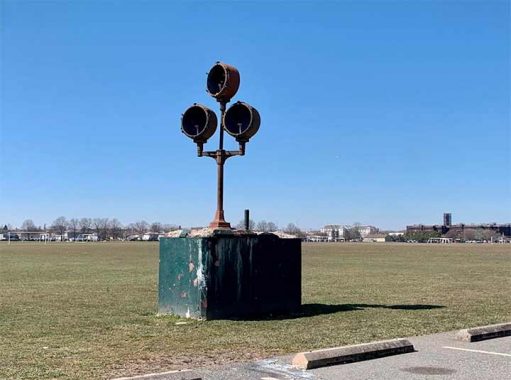
Where airplanes used to land, the field now hosts a variety of sports such as football, soccer, cricket, and softball. The triple beacon on the east side of the field hasn’t been lit since the 1960s. In the background is New Dorp High School, built in 1982 on land ceded from Miller Field. Three members of the local rap group Wu-Tang Clan are graduates of this school.
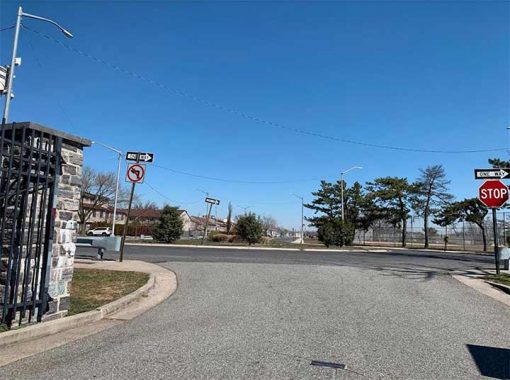
On the east side of Miller Field is Father Capodanno Boulevard (formerly Seaside Boulevard), the oceanfront road that follows Midland Beach and South Beach. It also has a military connection as its namesake was a local chaplain killed in the Vietnam War.
For more aviation history, here are my essays on the old hangars at LaGuardia Airport, and the former TWA terminal at JFK Airport. To see more vacant hangars, see Kevin’s 2003 essay on Floyd Bennett Field.
Sergey Kadinsky is the author of Hidden Waters of New York City: A History and Guide to 101 Forgotten Lakes, Ponds, Creeks, and Streams in the Five Boroughs (2016, Countryman Press), adjunct history professor at Touro University and the webmaster of Hidden Waters Blog.
As always, “comment…as you see fit.” I earn a small payment when you click on any ad on the site.
3/26/23

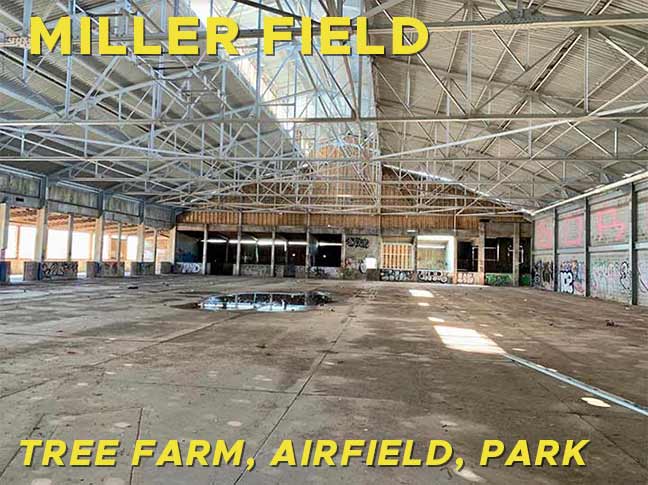
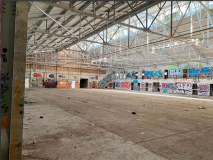
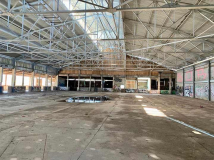
6 comments
Miller Field will always be a footnote to a terrible mid-air plane crash in New York on December 16, 1960. Two commercial airliners approaching New York, a United Airlines DC 8 jet and a TWA Constellation (propellor plane) collided in mid-air above Staten Island. The DC-8 was off its assigned course and hit the Constellation, which crashed onto Miller Field; the DC-8 continued descending and crashed in Park Slope, Brooklyn, at Seventh Avenue and Sterling Place. There were no survivors; all died on impact except for one child passenger on the DC-8 who died the following day.
Surprised the federal/city government hasn’t done more with Miller Field. Such a huge yet underused space, and kinda hard to reach by foot or public transit, hence the abandoned bocce court. Prior to Floyd Bennet Field opening in 1930, Miller Field was NYC’s only airfield. It was also the site of the city’s worst aircraft disaster until 9/11. Two airliners crashed into one another mid-air in 1960. One plane smashed into Park Slope, Brooklyn and the other fell onto Miller Field, miraculously missing the residential New Dorp neighborhood close by. Some 128 people on the two planes and six people on the ground in Park Slope died.
Same could be said for Floyd Bennett Field, turning a parking lot into an RV camping location. Tent sites seem OK.
One of the airplanes in the1960 midair collision crashed onto Miller Field, the other, more famous one crashing in Park Slope. By all indications the plane went completely out of control after the collision and the pilot was not trying to land at Miller Field. It just happened to crash there.
Even though Montauk JHS in Borough Park was miles away from the crash site, that Friday they wouldn’t let us out at lunch time because of all the fire dept. activity. My father drove us down to Park Slope on Sunday, and we had to park a 1/4 mile away. We could see the tail of the United Airlines plane on 7th Avenue. The lone survivor of the crash, an 11 year old boy traveling alone, was taken to nearby Methodist Hospital where he died the next day. There is a poignant memorial in the hospital chapel with a plaque containing the coins he had in his pocket that day.
As a kid, Miller Field was always my favorite place to visit. And what wasn’t to love? It’s a wide open grassy field, infinite space for a kid to run around and never run out of runway, as it were.
But then there’s also some scattered trees to provide shade, especially near the waterfront side. overall the place is a perfect picnic place. And i have always enjoyed it for that, and still do! It’s not often in NYC that you get what amounts to a wide open plain almost. Miller field is a gem.